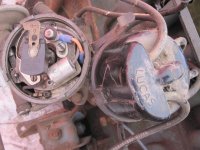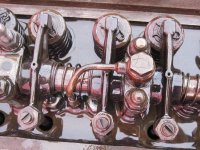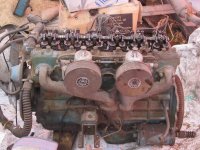This early 100-6 has not been on the road for forty or more years. It came with a couple of engines, including an early galley head engine - correct for the car's serial number. The former owner told me that someone had rebuilt the engine thirty years ago, or it could have been forty years ago, and never run it. It sat indoors, on the floor of a garage or barn, all these years. With the restoration moving along, it's time to start thinking about the drive train for this car.
Today, I began to check out the engine. The crankcase had oil in it, not quite up to the add mark on the dip stick. The oil looked very clean.
The valve cover came off easily, with no valve cover gasket in place. Everything looks fairly good under the valve cover, although a couple of the springs and spring caps had a little surface rust. Most did not look rusty at all. The pushrods, what I could see of them, and all the other parts there appeared free of rust. I poured about two liters of oil on everything and let it slowly seep down along the push rods, towards the cam shaft, etc.
The spark plugs were only finger tight and look new, except for dirt on their exterior. There was no rust on the ends of the plugs or on the threads, which gave me hope that the inside of the cylinders might not be rusty. I then squirted lots of oil into each cylinder before trying to turn the engine.
The inside of the distributor looks fine, with no rust visible. It looks as if someone redid the wiring in there. The carburetor parts and linkages move freely.
After giving the oil a bit of time to soak in, using a big socket on the front end of the crankshaft, I tried turning the engine. It turned with little resistance. Before turning it very far, I added more oil from the top and through the spark plug holes, and kept on repeating that procedure. The valve train moves up and down as it should, and the rotor in the distributor turns.
If you are still with me, now for the question(s).
Given the cost of rebuilding these Healey engines, what would you do?
One could also tear the engine apart and check all the parts. Even if all the moving parts are good, the engine would get new gaskets, and one would know better what one has.
Or one could put the engine on an engine stand, change the oil and oil filter, remove and clean the carburetors and air filters, and replace the fan belt and hoses. And then hit the starter and hope for the best.
Either way, the engine also would get new paint.
Here are a few pictures, complete with decades of accumulated dirt:




Today, I began to check out the engine. The crankcase had oil in it, not quite up to the add mark on the dip stick. The oil looked very clean.
The valve cover came off easily, with no valve cover gasket in place. Everything looks fairly good under the valve cover, although a couple of the springs and spring caps had a little surface rust. Most did not look rusty at all. The pushrods, what I could see of them, and all the other parts there appeared free of rust. I poured about two liters of oil on everything and let it slowly seep down along the push rods, towards the cam shaft, etc.
The spark plugs were only finger tight and look new, except for dirt on their exterior. There was no rust on the ends of the plugs or on the threads, which gave me hope that the inside of the cylinders might not be rusty. I then squirted lots of oil into each cylinder before trying to turn the engine.
The inside of the distributor looks fine, with no rust visible. It looks as if someone redid the wiring in there. The carburetor parts and linkages move freely.
After giving the oil a bit of time to soak in, using a big socket on the front end of the crankshaft, I tried turning the engine. It turned with little resistance. Before turning it very far, I added more oil from the top and through the spark plug holes, and kept on repeating that procedure. The valve train moves up and down as it should, and the rotor in the distributor turns.
If you are still with me, now for the question(s).
Given the cost of rebuilding these Healey engines, what would you do?
One could also tear the engine apart and check all the parts. Even if all the moving parts are good, the engine would get new gaskets, and one would know better what one has.
Or one could put the engine on an engine stand, change the oil and oil filter, remove and clean the carburetors and air filters, and replace the fan belt and hoses. And then hit the starter and hope for the best.
Either way, the engine also would get new paint.
Here are a few pictures, complete with decades of accumulated dirt:





 Hi Guest!
Hi Guest!

 smilie in place of the real @
smilie in place of the real @
 Pretty Please - add it to our Events forum(s) and add to the calendar! >>
Pretty Please - add it to our Events forum(s) and add to the calendar! >> 
